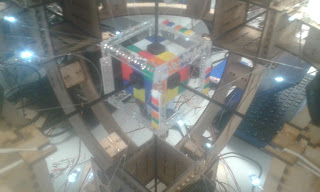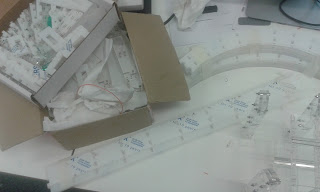Blake Project:
Yes, we finally handed it in, presented at an outreach event and semi-satisfied our supervisors. We managed to automate one of the cars, dictating it's behaviour with a learning state machine. This solution required us to quietly ignore that the 'learning' involved the car loosing control and falling from the track!
The final system did not include the brilliant perspex track, unfortunately I was not able to get the rails to be smooth enough to maintain reliable electrical contact with the cars as they travelled!
GrAVITAS:
I reckon that I will need to rename this project "The Han Solo Memorial" given how often it has gone into hibernation. Since the last post I discovered major potential instabilities in the planned circuit design, which scrapped the planned layout. Then University projects happened and we find ourselves a couple of months in the future.
Luckily I have now extensively tested new signal chain components (as a lucky byproduct of aforementioned University projects) which should mean that the hardware is put together very soon (fingers crossed)...
Robots: The Rock and A Hard Plaice, I and II
A bit more action here, mostly due to the fact that the Rock and a Hard Plaice suffered almost 50% fatalities per entry into a competition.
They were a blast to drive, not least because with two drivers the clusterbot became quite a sociable thing. Sadly weight saving measures left both bots rather vulnerable to more destructive opponents the first iteration of The Rock I fell victim to a vertical saw blade that discovered the only thing guarding The Rock's flammable lipo battery was a sheet of decorative paper!
 |
| Hmmm - I didn't intentionally add a fire weapon... |
Naturally once wasn't enough so I went about redesigning the cluster bot to be slightly better armoured, and actually used a 3d printer (splutter, splutter) to produce the chassis! Somewhat undaunted by the fact that I was greeted at the next competition by "are you going to explode again" from some very excited organisers The Rock and a Hard Plaice II managed to not die at all.
 |
| Sturdier, right... |
This was the result: https://youtu.be/N7zi8lK0Ia0?t=10m3s
(destruction occurs at around 10 mins 30 seconds)
I think the best bit was that I could find enough pieces to reconstruct the chassis and had to consolidate the available hardware into a single zombie-bot:
Rubik's Cube Solver:
Perhaps the most enjoyable project I have ever taken part in, the Rubik's Cube Solver has also been one of the most time consuming!
In the past few months I have been able to design, build, redesign, rebuild and debug the communications hardware and software for sending information over the mandated audio cable.
For those interested m hardware consisted of a Sallen-Key filter designed with the Analogue Devices filter wizard (all praise the filter wizard) with non inverting amplifiers acting as input and output impedance buffers. The actual demodulation was done with an envelope detector circuit. Modulation was done with software driving a PC soundcard.
Amusingly today was supposed to be the have-everything-working day for the project with a presentation next term. However not a single group managed to hit the deadline, mainly due to integration issues, which meant that the unit director pushed the deadline back in an act of supreme benevolence! My group was 99.999999% of the way to hitting the deadline before we discovered some rather tricky bugs involving envelope detector fall of times (yes ... that was my section) which we were unable to both generate and integrate a solution for in time.
Given the state of things I am sure that I will be able to post a victory video shortly...
 |
| In retrospect the decision to add the 'Hard Plaice' picture to the underside was somewhat disturbing... |
Perhaps the most enjoyable project I have ever taken part in, the Rubik's Cube Solver has also been one of the most time consuming!
In the past few months I have been able to design, build, redesign, rebuild and debug the communications hardware and software for sending information over the mandated audio cable.
For those interested m hardware consisted of a Sallen-Key filter designed with the Analogue Devices filter wizard (all praise the filter wizard) with non inverting amplifiers acting as input and output impedance buffers. The actual demodulation was done with an envelope detector circuit. Modulation was done with software driving a PC soundcard.
Amusingly today was supposed to be the have-everything-working day for the project with a presentation next term. However not a single group managed to hit the deadline, mainly due to integration issues, which meant that the unit director pushed the deadline back in an act of supreme benevolence! My group was 99.999999% of the way to hitting the deadline before we discovered some rather tricky bugs involving envelope detector fall of times (yes ... that was my section) which we were unable to both generate and integrate a solution for in time.
Given the state of things I am sure that I will be able to post a victory video shortly...
 |
| The initially planned communications tower, my demodulator fits into the second lowest box. |
 |
| Cube as it is now, with illuminating LED's and blackened actuation rods. |
 |
| The interior of the Demodulator box, I think the wiring leaves much to be desired! |
Aaaand ..... there we go all caught up. With three weeks of holiday coming up either many more posts are about to be made, or my next post will be in a couple of months time after the next academic term!



































